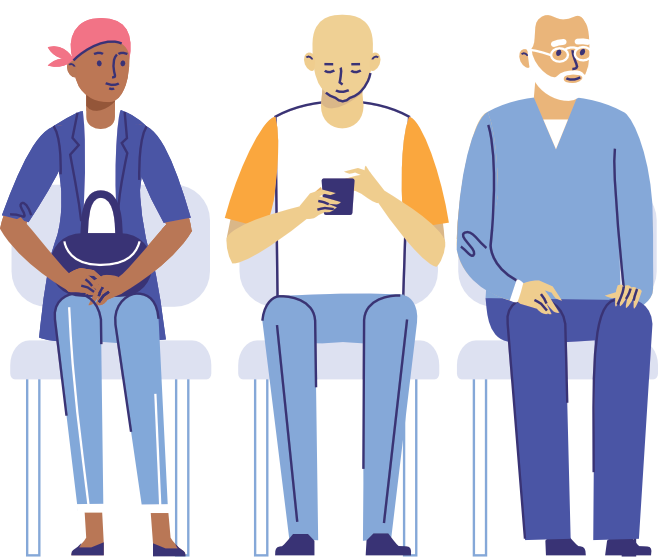Skin problems

What are cancer-related skin problems?
A cancer-related skin problem can be a side effect of cancer treatment or of the cancer itself. Your skin may feel itchy, burning or sensitive. You may develop a rash or changes to the colour of your skin. These are common skin problems and early treatment for these skin problems can reduce discomfort and risk of infection.
- How does it affect me? If your skin problems are uncomfortable in any way, they can affect how you move and carry out your everyday activities. Skin problems may also affect your sense of wellbeing. It is normal for your experience with skin problems to be different from someone else’s getting the same treatment. Everyone’s skin can react differently.
- Does it get better? Depending on the cause, a skin problem usually gets better after you finish treatment. Some may persist for a longer time than others. There are strategies that can help you manage a skin problem and relieve discomfort—see the section What can I do to help manage skin problems?.

What causes cancer-related skin problems?
Causes of skin problems can include:
- The cancer itself: You are more likely to have skin problems if you have cancer of the head and neck, breast, genitourinary system (genitals), melanoma or soft tissue sarcoma.
- Cancer treatments:
- Radiation therapy: A skin reaction can occur on the area of your body being treated. This kind of skin problem is called radiation skin reaction or radiation dermatitis. It usually starts 1 to 4 weeks after treatment begins, and can last for several weeks after the treatment finishes.
- Chemotherapy: This treatment can cause itchy or darker skin that will fade when treatment is finished. It also can cause your skin to be more sensitive to the sun. Some chemotherapy can cause skin changes to your hands and feet and is called a Hand-Foot Syndrome.
- Chemotherapy given at the same time as radiation therapy.
- Skin problems can also be caused by other cancer treatments, such as biotherapies, targeted therapy, or photodynamic therapy.

What are the signs of skin problems?
Skin reactions can appear in a number of different ways, depending on the cause.
What your skin might feel like:
- Painful
- Warm to touch
- Itchy
- Tingly, numb or burning
- Sensitive–perhaps tender to touch or more sensitive to the sun
What you might see:
- Skin redness
- Dry or peeling skin
- Skin rash
- Change in the skin colour or skin becoming darker (hyperpigmentation) or lighter (hypopigmentation)
- Change to fingernails or toenails

When should I get help for my skin problems?
Tell your oncologist, pharmacist, nurse, or pivot nurse if there are changes in your skin, especially if you develop sores on any part of your body. If you answer “yes” to any of the following questions, you should talk to a member of your healthcare team at your next appointment (For tips on talking with your healthcare team see Talking to your healthcare professional about your symptoms or concerns):
Does your skin feel different?
- Is there pain?
- Is it warm to touch?
- Does it itch, sting, or burn?
- Does it feel sensitive or numb?
- Is it tight, swollen, or thicker?
Does it look different?
- Is there a change in colour?
- Is there redness?
- Is there a rash, blisters, or sores?
If you have Hand-Foot Syndrome:
- Is there numbness, tingling, or burning in your feet and hands?
- Do the palms of your hands or the soles of your feet look red, feel tender or is the skin peeling?
Does your skin problem (including hand-foot syndrome) affect your daily activities and well-being?
- Can you carry out your groceries and household tasks?
- Does the problem wake you up at night? Does it keep you awake with no relief?
- Are you uncomfortable to see family and friends?
- Are you discouraged or worried about your skin problem?
Talk to someone in your healthcare team immediately if:
- You have a fever (temperature taken in your mouth of 38°C or higher)
- You have redness, oozing fluid (discharge), or a bad smell coming from an open sore
- You have pain or burning at the skin problem area that is getting worse
- You suspect an infection in your nails
- Your skin problem gets worse, or you are unable to do daily activities because of the skin problem
What can I do to manage my skin problems?
There are a number of simple ways to protect your skin from damage during treatment. Try the strategies listed here and ask your healthcare team if you have questions about how to manage your specific skin problems. Also ask for recommendations for cleansing and moisturizing products.
- Wash your skin in lukewarm water. To protect your skin, avoid rough washcloths and hot water.
- Use mild unscented soap and shampoo. Use products that are specifically for sensitive skin.
- Avoid skin irritants like alcohol or perfumed-based creams and scented laundry soap.
- To dry, gently pat your skin with a soft towel. Avoid rubbing or scratching as this can irritate or damage the skin. Be as gentle with your skin as possible.
- To remove unwanted hair, use an electric razor. Avoid wet razors, waxing, and hair removal creams as these may irritate your skin.
- Ask your healthcare team if swimming is ok for you. If it is ok, after swimming, remove your wet swimwear immediately. Take a shower and apply an unscented moisturizer (for sensitive skin) as soon as possible.
- Keep your body well hydrated. Drink plenty of fluids, unless you are told not to by your healthcare team.
- If your skin is dry, use clean hands to gently apply a moisturizer to your skin. Repeat often and avoid rubbing.
If you are having radiation therapy:
- For radiation skin reaction, use non-scented, lanolin-free water-based cream without vitamin E on intact skin.
- Follow the advice for skin care that your radiation oncology team gives you. Depending on the treatment area, the instructions might be different than other treatment areas.
- When radiation treatment is done and skin is healed, moisturize often and use sunscreen.
- Wash your hands before touching your skin.
- Avoid rubbing or scratching your skin as much as possible, even though this can be hard when you have an itchy rash. Rubbing or scratching can damage your skin, which can cause further skin problems or possible infection in the area.
- If you have Hand-Foot syndrome: avoid rubbing, friction or heat exposure. Wear comfortable shoes, avoid tight fitting socks and shoes.
- For itchy skin: Try oatmeal baths or a bath with baking soda. With Hand-Foot syndrome, use a cool compress. With radiation skin reaction, use a room temperature saline water compress, up to 4 times per day.
- Avoid exposing your skin to extreme temperatures, such as during vigorous exercise or using a sauna, hot tub, heat pads, or ice packs.
- Avoid direct sunlight and wind. Wear a wide-brimmed hat and protective clothing to protect your skin from drying out or sun damage. Ask your healthcare team if sunblock is ok for your skin, especially if you are receiving cancer treatment.
- Wear loose and breathable clothing, made of natural fabrics such as cotton. Avoid wearing tight clothing, belts, or jewelry. This will help keep you comfortable if your skin is sensitive or painful. It also will protect your skin from further damage.
- Avoid using tight bandages, dressings, or adhesive tape, such as bandaids.
⚠ Important information about cannabis
Some patients do use cannabis to reduce pain, help with relaxation or as a sleeping aid. However, the research is still unclear about the use of cannabis to manage cancer-related symptoms, including skin problems. It is important to talk to your doctor before trying cannabis. For more information on what cancer patients should know about cannabis, go to: www.bccancer.ca/health-info/coping-with-cancer/medical-cannabis.
Resources
For more information on skin problems, self-management strategies, and support organizations, check out the resources below.
BC Cancer – Radiation Therapy – What to Expect
National Cancer Institute – Skin and Nail changes during Cancer Treatment
American Cancer Society – Skin Problems
Canadian Cancer Society – Skin Problems
Chemocare – Hand-Foot Syndrome
Cancer.Net – Skin Reactions to Targeted Therapy and Immunotherapy
Acknowledgement of sources
The content of this document has been adapted from the following sources:
- BC Cancer. Skin & Wounds. 2016
- BC Cancer. Symptom Management Guidelines: Acneiform Rash. 2016
- BC Cancer. Symptom Management Guidelines: Radiation Dermatitis. 2018
- BC Cancer. Care of Radiation Side Effects: Skin Care, 2019.
- Canadian Cancer Society. Skin Problems. 2020
- Skin Reaction to Radiation Practice Guide. 2020
- Skin Rash Practice Guide. 2020
Healthcare professional endorsement
The content of this document has been reviewed and approved by a team of healthcare professionals and clinical experts.
Disclaimer
Please note that this fact sheet is not intended as a substitute for consultation with a healthcare professional. Rather, it was designed to complement interventions by your treating team. If you have questions about your health, or any medical issue, you should contact a healthcare professional right away. You should not delay seeking medical advice, or disregard professional medical advice, because of information in this fact sheet. Before beginning any health treatment, always consult your doctor. All care has been taken to ensure that the information contained in this document is accurate at the time of publication. e-IMPAQc is not responsible for any injury or damage to persons or property arising out of, or related to, any use of the fact sheet, or because of any errors or omissions.
Reproduction and copyright
Any reproduction or distribution, in whole or in part, of this webpage is prohibited without obtaining prior written consent of the e-IMPAQc project lead. Permission can be obtained by writing to e.impaqc.comtl@ssss.gouv.qc.ca.

